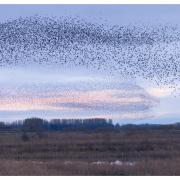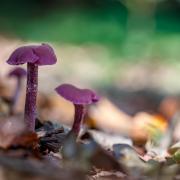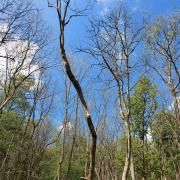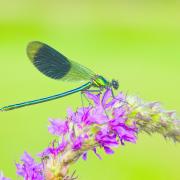Abundant orchards, crisp leaves and a firework of autumn colour – our guide to the season’s best

Autumn leaves and abundant orchards
Does anything conjure up the image of autumn more than falling leaves in vibrant shades of red, orange and yellow? Yorkshire has wonderful woodlands aplenty to explore, from the oak and beech trees at Hardcastle Crags (nationaltrust.org.uk) to Thorp Perrow (thorpperrow.com) and the Yorkshire Arboretum (yorkshirearboretum.org) at Castle Howard.
Yorkshire Arboretum’s director John Grimshaw says: ‘Autumn here is like a slow-motion firework display: first one group of trees will colour up – perhaps a group of birch turning clear yellow – then another comes on and does its thing in a brilliant burst, for example hickories turning gold for just a few days. And there’s the long slow burn of the ‘October Glory’ red maples, heating up from September onwards and peaking perhaps in early November when the oaks and beeches are also at their best. As well as the leaves there are berries to enjoy: many colours of sorbus from Europe and Asia, red viburnum berries, and the startling pink and orange confection that are the fruits of our native spindle bush. Maple keys twirl down elegantly, and long chains of wingnuts hang green among the leaves.’
There really is no better time to don your walking boots and visit the arboretum, particularly as it is appealing for funds to help with the shortfall caused by the Covid lockdown, and enable it to complete a Tree Health Centre. ‘This will give us the opportunity to teach people about the many pests and diseases our trees are suffering from and encourage everyone to think about healthy trees for a healthy future,’ continues John. ‘The wellbeing benefits of green spaces and trees are being appreciated more than ever this year.’
If you’re rambling with small children, remember to take a bag, collect up some of the prettiest fallen leaves, then search on Pinterest for ‘leaf crafts’ when you get home – perfect for those less clement autumn days.
Prefer your trees laden with seasonal fruit? Beningbrough Hall (nationaltrust.org.uk) has more than 40 varieties of apples and pears ripening at this time of year, or admire the plums, damsons, cherries and apples at Helmsley Walled Garden (helmsleywalledgarden.org.uk).

Foraging for treasure
While you’re out enjoying the beautiful Yorkshire landscape, you might be tempted to do a bit of foraging – and there’s no better time than autumn. Local expert Chris Bax shares his recommendations of what to look out for: ‘October is great for fungi, but you have to know what you’re doing. Yorkshire has some fantastic mycological societies who can help you identify the fungi you find (visit britmycolsoc.org.uk to find your local one), or try the Collins Gem Mushrooms book by Patrick Harding. And never eat anything you can’t positively identify.
‘Another great ingredient is acorns. The oak is our national tree, but we don’t tend to use the acorns as ingredients, while in Italy they’re making acorn pasta, acorn noodles and more. They need to be processed, but once you’ve shelled, chopped and roasted them, they can be infused into milk or cream to make ice cream or panna cotta, or put in a cafetiere and used as acorn coffee. It’s delicious – like a chocolate, caramel, malt drink, and caffeine-free, though it does contain tannins.
‘Over on the coast, you can collect some brilliant seaweeds. Anything you find clinging to a rock is edible, but some of the best types are laver, dulse and pepper dulse. And while you’re there, look out for the prickly bushes of sea buckthorn, which grows naturally all down the coast. The berries are face-puckeringly tart, but they taste great once the acidity is tempered in an ice cream or a drink.
‘The law states that as long as you’re foraging for your own use, it’s fine to take fruit, flowers, fungi and foliage from the wild, but that doesn’t include roots,’ says Chris. ‘Once you uproot something, it becomes theft. A good rule of thumb for foragers is that if you walk away from an area where you’ve been, does it look like anyone has been there and taken anything? If not, great. You want to make little or no impact on the eco system.’
If you fancy trying your hand at foraging, but would rather be guided by an expert, booking onto a course is your best bet. Chris’s company Taste the Wild (tastethewild.co.uk) runs one-day foraging courses from its private woodland in North Yorkshire, as well as venturing to Robin Hood’s Bay for some coastal treats. Or try Leeds-based Lisa Cutliffe’s Edulis Wild Food (eduliswildfood.co.uk); she leads guided foraging walks around Yorkshire. But if donning your waterproofs and rooting out your own mushrooms sounds a bit too much like hard work, you can sit back and enjoy the fruits of someone else’s labour by visiting one of the many restaurants in Yorkshire with a focus on foraged food. Tommy Banks’ Black Swan at Oldstead (blackswanoldstead.co.uk) and Roots York (rootsyork.com) are well known for their foraged fare and homegrown produce. Elsewhere, try Grantley Hall in Ripon (grantleyhall.co.uk) or Samuel’s Restaurant at Swinton Park (swintonestate.com), where the chefs have been trained in foraging by Chris Bax.

Look to the sky
‘There’s some great birdlife to be seen in Yorkshire in October,’ says the RSPB’s Sydney Henderson. ‘Starlings begin to gather before their large-scale murmuration spectacles later in the year – thousands of birds all swooping and diving in unison. It’s completely breathtaking. RSPB Old Moor (rspb.org.uk) in the Dearne Valley is a good spot to see them.
‘A great variety of ducks that breed further north in Scandinavia come to the UK to spend the milder winter months here. Wigeons are a key one in Yorkshire, and are a regular at most local RSPB reserves (try Fairburn Ings in Castleford or St Aidan’s in Leeds). You’ll also get pintails, teals, goldeneyes, tufted ducks, shoveler and gadwall. And keep an eye out for birds of prey at sites such as Fairburn Ings and Bempton Cliffs. Autumn and winter are perhaps the best seasons for seeing owls such as barn owls and short-eared owls.’
Want to help the birds in your own back garden? ‘Autumn is usually a time when birds have access to plenty of food in the form of nuts and berries,’ says Sydney. ‘So just keep a little fresh food in your feeders, so that as birds pass through, they will see food is there and return when it gets colder. The best type of bird feed is a mix of high-quality seed, fat and mealworms. Ensure you have some late-flowering plants, such as Michaelmas daisies, sedums and asters. Let perennials form attractive seedheads, and include some native plants in your garden, such as crab apple, holly, elder, birch or hawthorn. All of these are natural food supplies for birds.’



























